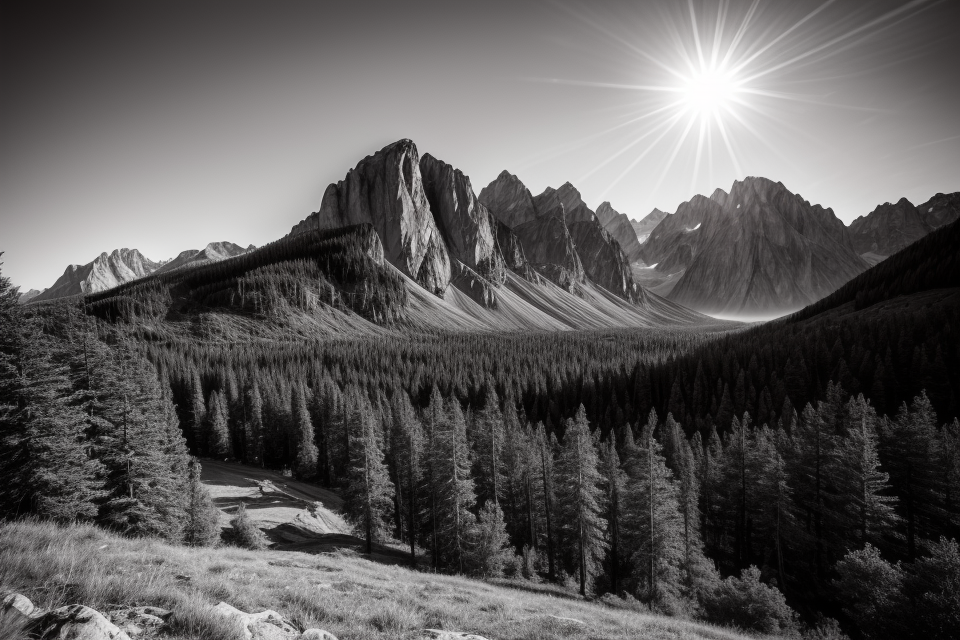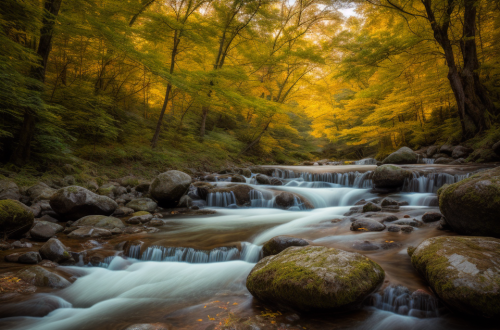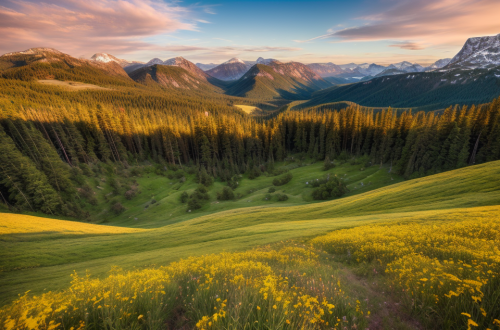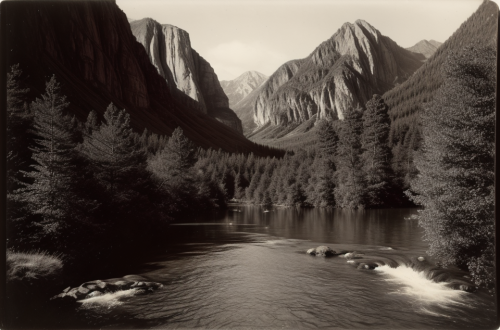Have you ever stood in awe of a breathtaking view, wanting to capture its beauty forever? Well, that’s exactly what landscape photographers do! But when did this fascination with the natural world start? Join us as we embark on a journey through time, exploring the evolution of landscape photography from its humble beginnings to the stunning masterpieces we see today. Get ready to be captivated by the magic of nature, as we uncover the secrets behind this mesmerizing art form.
The Beginnings of Landscape Photography
The Invention of Photography
The First Photographs
The invention of photography can be traced back to the early 19th century, when the first permanent photograph was produced by Joseph Nicéphore Niépce in 1826. Niépce used a process called heliography, which involved using a surface coated with bitumen to capture an image formed by sunlight passing through a small hole. This image was then exposed to light for several hours, resulting in the production of a one-of-a-kind photograph.
The Early Landscape Photographers
As photography continued to develop, so too did the use of landscape photography as a means of capturing and preserving the beauty of the natural world. Some of the earliest landscape photographers include William Henry Fox Talbot, who is credited with inventing the calotype process in 1841, and Roger Fenton, who was known for his images of the Crimean War.
These early photographers were limited by the technology of the time, and were often forced to work with long exposures and large, cumbersome equipment. Despite these challenges, they were able to capture stunning images that captured the majesty and beauty of the natural world.
One of the most iconic early landscape photographs is “The Great Wave” by Katsushika Hokusai, which depicts a massive wave about to crash over a rocky shoreline. This image, created in the late 1820s or early 1830s, is now considered a masterpiece of Japanese art and a defining moment in the history of landscape photography.
Overall, the invention of photography marked a major turning point in the history of landscape art, allowing artists to capture and preserve the beauty of the natural world in a way that had never been possible before.
The Emergence of Landscape as a Genre
The Aesthetics of Landscape Photography
The aesthetics of landscape photography were shaped by the early pioneers of the medium, who sought to capture the beauty and majesty of the natural world. These photographers, such as William Henry Fox Talbot and William James Bennett, experimented with different techniques and approaches to create images that were both technically proficient and aesthetically pleasing.
One of the key aesthetic principles of landscape photography was the idea of the “sublime,” which referred to the sense of awe and wonder that one feels in the presence of nature’s grandeur. Photographers sought to capture this feeling in their images, often by emphasizing the vastness and power of the natural world.
The Cultural Significance of Landscape
In addition to its aesthetic significance, landscape photography also had cultural and social implications. For example, the emergence of landscape photography coincided with the rise of tourism and the growth of leisure activities, such as hiking and camping. Landscape photographs were often used to promote these activities and to encourage people to explore and appreciate the natural world.
Furthermore, landscape photography was also used to document and promote the expansion of the United States and other colonial powers. Photographs of the American West, for example, were used to promote the idea of “Manifest Destiny” and to justify the displacement and removal of indigenous peoples.
Overall, the emergence of landscape as a genre was marked by a growing appreciation for the beauty and power of the natural world, as well as its cultural and social significance. As the medium continued to evolve, landscape photographers would continue to push the boundaries of what was possible and to explore new ways of seeing and representing the world around them.
The Golden Age of Landscape Photography
The Hudson River School
The Art of Landscape Painting
During the 19th century, landscape painting emerged as a prominent art form in the United States. The Hudson River School, named after the river that flowed through the region, was a group of American artists who sought to capture the beauty and majesty of the American wilderness. They focused on the natural landscape, particularly the Hudson River Valley and the surrounding areas, and depicted it with romanticized realism. Their works often featured grand vistas, towering mountains, cascading waterfalls, and tranquil rivers, all of which helped to shape the public’s perception of the American landscape.
The Impact of the Hudson River School on Landscape Photography
The Hudson River School had a profound impact on the development of landscape photography. The artists of the school sought to capture the sublime beauty of the American wilderness, which later became a hallmark of landscape photography. Their works were characterized by their attention to detail, their use of light and color, and their ability to evoke a sense of awe and wonder in the viewer.
In addition, the Hudson River School’s focus on the American landscape helped to shape the national identity of the United States. The artists of the school portrayed the landscape as a symbol of American progress and Manifest Destiny, and their works were widely reproduced and distributed throughout the country. As a result, the Hudson River School’s depictions of the American landscape became a powerful tool for shaping the public’s perception of the nation’s natural resources and its relationship to the land.
Overall, the Hudson River School played a crucial role in the evolution of landscape photography. Their works influenced the way that photographers approached the landscape, and their emphasis on the sublime beauty of the American wilderness helped to shape the nation’s cultural identity.
The British Landscape Tradition
The Picturesque and the Sublime
The British landscape tradition emerged during the late 18th and early 19th centuries, marked by two significant aesthetic movements: the Picturesque and the Sublime. The Picturesque, a concept originating from British landscape painter Richard Payne Knight, emphasized the importance of capturing natural scenes that were aesthetically pleasing and evoked a sense of surprise, variety, and an informal quality. It was a rejection of the formal, symmetrical landscapes of the past, and it influenced many photographers in the British Isles.
On the other hand, the Sublime sought to capture the awe-inspiring, powerful, and often terrifying aspects of nature. It was influenced by the work of philosopher Edmund Burke, who believed that beauty and terror were closely connected. Sublime landscapes often featured vast, untamed wildernesses, such as mountains, waterfalls, and rugged coastlines, which invited the viewer to contemplate the power and majesty of nature.
The Role of Technology in Landscape Photography
The development of photographic technology played a crucial role in the evolution of landscape photography during the British landscape tradition. The introduction of the calotype, an early photographic process invented by William Henry Fox Talbot, allowed photographers to capture and produce images more efficiently. This enabled them to explore the picturesque and sublime qualities of the British landscape in greater detail, capturing its beauty and grandeur with greater accuracy.
The invention of the collodion process, which offered improved negatives and faster exposure times, further revolutionized landscape photography. Photographers such as William Turner and Edward Chamney used this process to create breathtaking images of the British countryside, capturing its dramatic light and shadow, and showcasing its diverse natural beauty.
The ongoing advancements in photographic technology during this period allowed photographers to push the boundaries of landscape photography, experimenting with new techniques and capturing ever-more stunning images of the British landscape. These innovations paved the way for future generations of photographers to continue exploring and capturing the essence of the picturesque and sublime in their work.
The Modern Era of Landscape Photography
The Rise of Color Photography
The Technical Developments in Color Photography
In the early 20th century, the first color photography processes emerged, such as the Autochrome plate, which used a screen of colored particles to capture the colors of a scene. Later, in the 1930s, the Technicolor process was developed, which used three black and white film emulsions shot through different color filters to create a color image. However, it wasn’t until the 1960s with the advent of Kodachrome film that color photography became more widely accessible to amateur photographers.
Kodachrome was the first commercially successful color film, and it offered good color saturation and relatively fine grain. Its success was due in part to the Kodak company’s marketing efforts, which emphasized the “realism” of color photography. The film was used by many photographers, including some of the most renowned landscape photographers of the time, such as Ansel Adams and Minor White.
In the 1970s, Kodak introduced Kodachrome II, which offered improved color accuracy and reduced the amount of grain in the final print. However, Kodachrome’s popularity began to decline in the 1980s as digital photography started to become more popular. In 2010, Kodak stopped producing Kodachrome film, marking the end of an era for color photography.
The Impact of Color on Landscape Photography
The rise of color photography had a profound impact on landscape photography. Color added a new dimension to the medium, allowing photographers to capture the full range of light and color in the landscape. This allowed for a more accurate representation of the natural world, and it also opened up new creative possibilities for photographers.
For example, photographers could now use color to create mood and atmosphere in their images, and they could use color to draw the viewer’s attention to specific elements in the scene. Additionally, color photography allowed photographers to capture the subtle changes in light and color that occur throughout the day, adding a sense of time and movement to their images.
Overall, the rise of color photography in the 20th century marked a significant turning point in the evolution of landscape photography, allowing photographers to capture the full beauty and complexity of the natural world in a way that had never been possible before.
The Diverse Styles of Contemporary Landscape Photography
Contemporary landscape photography is characterized by its diversity of styles, as photographers continue to push the boundaries of the genre. This diversity is influenced by a variety of factors, including the use of digital technology, the impact of fine art and documentary photography, and the individual vision and style of each photographer.
The Role of Digital Technology in Contemporary Landscape Photography
Digital technology has had a profound impact on the field of landscape photography. With the advent of digital cameras and software, photographers have greater control over the final image than ever before. This has led to new techniques and approaches, such as the use of digital manipulation and post-processing to create images that are often more abstract and surreal than those produced with traditional film photography.
The Influence of Fine Art and Documentary Photography on Landscape Photography
Fine art and documentary photography have also had a significant influence on contemporary landscape photography. Many photographers are now exploring the conceptual and artistic possibilities of the genre, creating images that are less about representing a specific place and more about expressing a personal vision or exploring a particular theme.
In addition, documentary photographers are using landscape photography to tell stories and raise awareness about social and environmental issues. This has led to a new kind of landscape photography that is both visually stunning and politically engaged.
Overall, the diversity of styles in contemporary landscape photography reflects the genre’s continued evolution and its ongoing relevance to photographers and audiences alike.
The Future of Landscape Photography
The Impact of Climate Change on Landscape Photography
The Changing Landscapes and Their Impact on Photography
- Rising sea levels and erosion threaten iconic coastal landscapes, such as the cliffs of Dover in England and the beaches of Miami Beach, Florida.
- Increased frequency and intensity of extreme weather events, such as hurricanes and wildfires, have led to significant changes in landscapes, including the loss of forests and the alteration of river systems.
- As glaciers recede, alpine landscapes are transforming, altering the character of mountain ranges and the ecosystems that depend on them.
The Ethics of Landscape Photography in a Changing World
- The ethical implications of capturing and documenting landscapes that are in the process of being altered or destroyed by climate change.
- The role of landscape photographers in raising awareness about the impacts of climate change on the environment and communities.
- The need for responsible and sustainable practices in landscape photography, such as minimizing carbon emissions from travel and promoting environmental conservation efforts.
The Continued Evolution of Landscape Photography
The Intersection of Landscape Photography with Other Genres
Landscape photography has traditionally been a standalone genre, with photographers dedicating their efforts to capturing the beauty of the natural world. However, in recent years, there has been a growing trend of intersection between landscape photography and other genres, such as portraiture, documentary, and fine art. This convergence has led to the creation of new and innovative forms of landscape photography, pushing the boundaries of what was previously considered possible within the genre.
The Continued Exploration of the Human Connection to Landscape
Another important aspect of the continued evolution of landscape photography is the exploration of the human connection to the natural world. This has led to the development of a new form of landscape photography that focuses on the relationship between humans and the environment. This approach acknowledges the impact that humans have on the environment and seeks to highlight the ways in which we are interconnected with the natural world.
Technology has also played a significant role in the evolution of landscape photography. Advancements in digital cameras and editing software have allowed photographers to capture and manipulate images in ways that were previously impossible. This has led to the creation of new and innovative forms of landscape photography, such as aerial and drone photography, which offer unique perspectives on the natural world.
The Emergence of Environmental Landscape Photography
In recent years, there has been a growing trend of environmental landscape photography, which focuses on documenting the impact of human activity on the environment. This approach seeks to raise awareness of the environmental challenges facing our planet and to inspire action towards a more sustainable future.
The Influence of Social Media on Landscape Photography
Social media has also had a significant impact on the evolution of landscape photography. Platforms such as Instagram and Facebook have provided photographers with a global audience, allowing them to share their work with a much wider audience than was previously possible. This has led to the emergence of a new generation of landscape photographers who are inspired by the work of others and who are constantly pushing the boundaries of the genre.
Overall, the continued evolution of landscape photography is driven by a desire to explore new and innovative ways of capturing the beauty of the natural world. Whether through the intersection of landscape photography with other genres, the exploration of the human connection to the environment, the role of technology, or the influence of social media, the genre is constantly evolving and adapting to the changing world around us.
FAQs
1. When was landscape photography first introduced?
Landscape photography has its roots in the early days of photography. It is believed that the first ever landscape photograph was taken in the early 1800s by French photographer, Nicéphore Niépce. However, it was not until the mid-1800s that landscape photography became a popular genre, with photographers such as Carleton Watkins and William Henry Jackson capturing stunning images of the American West.
2. How has landscape photography evolved over time?
Landscape photography has come a long way since its inception. In the early days, photographers had to rely on cumbersome equipment and slow exposure times, which limited their creativity. However, with the advent of digital cameras and advanced editing software, landscape photographers today have a much wider range of tools at their disposal. This has allowed them to capture more diverse and dynamic images, and to experiment with new techniques such as long exposures, time-lapses, and drone photography.
3. Who were some of the most influential landscape photographers?
There have been many influential landscape photographers throughout the history of the genre. One of the earliest and most influential was Carleton Watkins, who captured stunning images of the American West in the mid-1800s. Other notable landscape photographers include Ansel Adams, who is known for his black and white images of the American West, and Edward Weston, who was known for his striking portraits and still lifes. More recently, photographers such as Alex Noriega and James Balog have pushed the boundaries of landscape photography, using new techniques and technologies to capture breathtaking images of the natural world.
4. What are some of the key themes in landscape photography?
Landscape photography often explores themes such as the relationship between humans and the natural world, the passage of time, and the beauty and majesty of the natural world. Many landscape photographers also explore the impact of human activity on the environment, and the ways in which we interact with and shape the landscapes around us.
5. How has the digital age impacted landscape photography?
The digital age has had a profound impact on landscape photography. With the advent of digital cameras and advanced editing software, photographers now have a much wider range of tools at their disposal. This has allowed them to capture more diverse and dynamic images, and to experiment with new techniques such as long exposures, time-lapses, and drone photography. It has also made it easier for photographers to share their work with a wider audience, through social media and online galleries.





